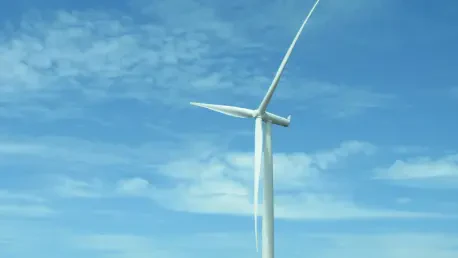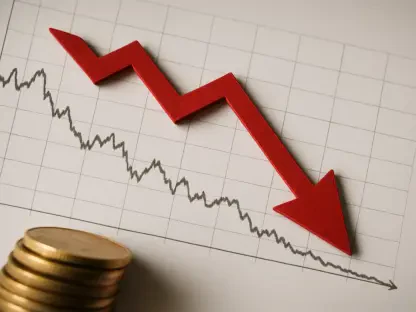The renewable energy sector in the United States stands at a critical juncture, grappling with sweeping policy changes under President Donald Trump’s second term. Recent cuts to incentives and the introduction of trade tariffs have sparked intense debate about the future of solar and wind power, with projections estimating a staggering 53-59% drop in new clean power capacity by 2035. This roundup dives into diverse perspectives from industry leaders, analysts, and stakeholders to uncover how these shifts are reshaping the clean energy landscape. The purpose is to synthesize varying opinions, highlight actionable insights, and provide a comprehensive view of the challenges and potential pathways forward for renewable energy amidst federal pushback.
Policy Reversals: A Hostile Environment for Renewables
Impact of Incentive Cuts on Developer Confidence
Industry voices express deep concern over the rollback of tax credits and subsidies that once fueled solar and wind projects. Analysts from prominent research groups note that the uncertainty stemming from these policy changes has led to a significant erosion of trust among developers, with many reevaluating long-term commitments. The consensus points to a chilling effect on new project initiations, as financial predictability vanishes.
Contrasting views emerge on the severity of this impact. Some industry insiders argue that while large-scale developers may weather the storm by leveraging existing resources, smaller firms face existential threats due to limited capital. This disparity raises questions about market consolidation and the potential loss of innovation from diverse players.
A differing perspective suggests that short-term political priorities are overshadowing the long-term environmental benefits of renewables. Stakeholders caution that this approach risks derailing national clean energy goals, urging a reevaluation of how such cuts align with broader economic and sustainability objectives. The tension between immediate fiscal strategies and enduring climate commitments remains a central point of contention.
Project Delays and Cancellations: Real-World Consequences
Feedback from project managers highlights a wave of setbacks, with major solar and wind initiatives either stalled or scrapped due to regulatory hurdles and funding shortages. Reports indicate that tightened scrutiny on federal lands has directly contributed to these disruptions, affecting ambitious plans across multiple states. The ripple effects are palpable, as timelines stretch indefinitely for many.
Some industry observers emphasize the economic fallout, pointing to a sharp decline in investment—down by a reported 36% in recent assessments. This drop not only hampers current projects but also deters future ventures, creating a vicious cycle of reduced momentum. Smaller developers, in particular, struggle to secure financing under these conditions.
On the other hand, a minority of analysts argue that not all hope is lost, as a small fraction of projects unaffected by federal oversight may still proceed. However, even this optimism is tempered by warnings that without systemic support, the scale of progress needed to meet clean energy targets remains out of reach. The broader narrative underscores a sector teetering on the edge of stagnation.
Economic Pressures: Tariffs and Rising Costs
Trade Policies Driving Up Project Expenses
Insights from market analysts reveal that new tariffs on essential materials like steel and aluminum have significantly inflated costs for renewable energy projects. Data suggests a 14% increase in wind power purchase agreement prices, a trend that threatens to cascade into higher electricity rates for consumers. This financial burden adds another layer of complexity to an already strained industry.
Regional disparities amplify these challenges, as some areas face steeper cost hikes due to supply chain dependencies. Industry leaders warn that without mitigation, these economic pressures could undermine the affordability of clean energy, countering the narrative that prioritizing traditional fuels will benefit end users. The long-term implications for household budgets are a growing concern.
A counterpoint comes from a segment of commentators who suggest that domestic manufacturing could eventually offset tariff impacts by reducing reliance on imports. Yet, most agree that such a transition would require years of investment and policy stability—conditions currently absent. The immediate reality of escalating expenses dominates the discussion, casting doubt on short-term relief.
Corporate Shifts: Big Energy’s Retreat from Green Targets
Corporate responses to policy uncertainty paint a picture of strategic retreat, with major oil and gas companies scaling back renewable ambitions to focus on fossil fuel reserves. Earnings discussions reveal a pragmatic pivot, driven by the need to align with current federal priorities. This shift is seen as a direct consequence of diminished incentives for green investments.
Some energy sector analysts argue that this retreat is not absolute, as companies remain wary of future liabilities under potential policy reversals. A cautious approach emerges, with firms maintaining minimal clean tech initiatives as a hedge against long-term risks. This balancing act reflects the uncertainty permeating the industry.
Diverging opinions highlight the potential cost of innovation stagnation due to reduced corporate engagement in renewables. While some believe market forces could eventually drive a return to green goals, others fear that delayed progress might hinder technological advancements critical for the energy transition. The debate continues on whether this corporate caution will have lasting detrimental effects.
Strategies and Solutions: Navigating Federal Barriers
State-Level Action as a Counterbalance
Stakeholders across the board advocate for state-level interventions to fill the void left by federal cuts. Many point to the economic benefits—such as job creation and tax revenue—that renewables bring to local communities, suggesting that state governments have a vested interest in supporting these projects. This localized focus offers a potential lifeline amidst national challenges.
Analysts recommend that developers actively lobby for state-specific policies that bolster clean energy, such as grants or streamlined permitting processes. Examples of states with strong renewable portfolios are often cited as models to emulate, providing a blueprint for others to follow. The emphasis on grassroots momentum is a recurring theme in these discussions.
A contrasting viewpoint warns that state action, while promising, may not fully compensate for federal-level setbacks due to varying resources and political will. Nonetheless, the collective opinion leans toward leveraging regional strengths as a critical strategy, urging collaboration between public and private entities to sustain growth in the sector.
Practical Tips for Developers in a Constrained Market
Industry advisors stress the importance of securing remaining tax credits before looming deadlines, such as mid-2026. This rush to lock in benefits is seen as a vital step for maintaining project viability, especially for those with shovel-ready initiatives. Timely action could mean the difference between progress and collapse for many firms.
Diversifying funding sources emerges as another key recommendation, with experts suggesting partnerships, private equity, and community-backed models to offset federal funding gaps. Such approaches aim to spread financial risk and ensure projects remain afloat despite policy headwinds. Creativity in financing is increasingly viewed as essential.
Finally, some voices call for a focus on efficiency and cost-cutting measures within projects to counteract tariff-driven expenses. Streamlining operations and prioritizing high-impact developments are advised as ways to navigate the current economic squeeze. This pragmatic mindset underscores the resilience needed to endure ongoing uncertainties.
Reflecting on the Insights Gained
Looking back, this exploration of expert opinions and industry analyses paints a vivid picture of a renewable energy sector under significant strain from Trump’s policy cuts. Discussions revealed a landscape marked by dwindling developer confidence, halted projects, rising costs due to tariffs, and a cautious retreat by major corporations from green commitments. Despite these challenges, the varied perspectives underscored pockets of resilience, particularly through state-level initiatives and strategic adaptations by developers. Moving forward, stakeholders are encouraged to prioritize securing existing incentives, advocate for localized policies, and explore innovative funding to mitigate federal barriers. As the clean energy transition hangs in the balance, staying informed on evolving state actions and industry trends will be crucial for navigating this turbulent period.









